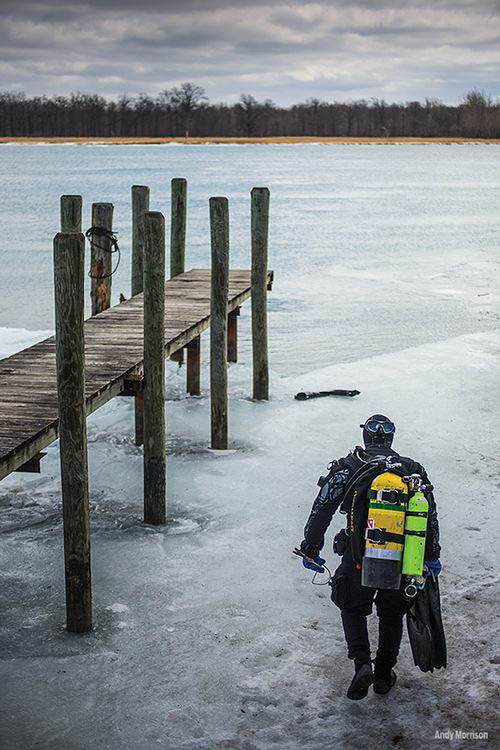A few of my fellow dive buddies have recently quipped, “I hate winter, can’t go diving.” For those of us who live in the cold climates, winter can be several months of staring out the window waiting for the “big thaw.” However, it doesn’t have to be. You can max out your credit cards, pack your gear and weigh it time after time to make sure the airline accepts it for your flight to somewhere tropical. Let’s be honest, though, sticking to warm water diving with blue water and endless visibility is great, but how much can you afford?

Winter diving, or even cold-water diving, is going require a bit if an investment in additional gear and training, but the pay off may well be worth it. Being able to dive in cold water during the winter means a much longer dive season. You are in the water earlier in the season, as soon as the ice is gone, and can stay the water in until it returns.
When it comes to gear the greatest investment for diving in cold water is a drysuit and the training to go with it. At the mention of drysuit most people hear the cash register ringing, and feel the intensity of the glare of their spouse as you spend more money on an already pricey hobby. What is the joke? “My greatest fear in death is my spouse will sell my gear for what I told them I paid!” This always gives me a chuckle, because it’s true.
A drysuit, like so many pieces of gear doesn’t have to be as pricey as we fear. I bought my first drysuit from a shop offering a promotion after a dive show. I think I paid $800 for it. It worked well, and with maintenance, and a few seal changes, I’m still wearing it years later. As an incentive, many dive shops will include drysuit training as part of the purchase price of the suit. Even if the training isn’t included, it’s still affordable.
If you’re venturing into cold water you’re going to want to make sure that your regulators are also suitable for cold water diving. Check with your shop, if unsure. Most quality regulators are configured to handle colder temperatures, but it’s always good to confirm your regs are up to the task.
But the big question is why? I have to be honest, sitting here inside and warm, and knowing it’s freezing cold outside, it doesn’t seem too appealing. The idea of going out in the morning in the midst of an arctic vortex, getting into a drysuit and jumping in the water doesn’t seem very appealing. Add in the part where you get out of the water into that freezing cold arctic vortex, and it seems even less appealing! I’ve done it many times though. And it’s worth it.
With the cold water comes much improved visibility. Particulate and algae in the water that has grown with the warmth of the summer, has died and gone. Dive a shipwreck you’ve only dived in warm water and you’ll see it in a whole new way, with a much clearer view. If you’re into photography, the water clarity provides phenomenal photo opportunities. Added to that, I can pretty much guarantee that you and your buddies will be the only divers at the site.
Of course, if you’re going to ice dive, you’ll need to a course for that too. Instructors that run these courses often set up shelters with some form of heat, warm beverages, and all the things to keep you comfortable. There’s also a comradery that comes with standing on a frozen lake with your dive buddies waiting for your chance to jump into a hole that’s been cut into the ice. Speaking of which, there aren’t many dive courses you’ll take that require a chainsaw as part of your kit. Ultimately, ice diving may not be your thing, but what the course will do for you is introduce you to the additional skills and equipment required to dive in cold, very cold water. You’ll be ready to dive at remarkable places such as Tobermory, Newfoundland, and the Great Lakes all of which boast crystal clear water and beautifully preserved wrecks.
In the end, if you’re willing to make the additional investments in gear and training for cold water diving, you’ll be rewarded in spades. Your dive season will be lengthened and you’ll be better prepared to dive fantastic new dive sites and shipwrecks.





